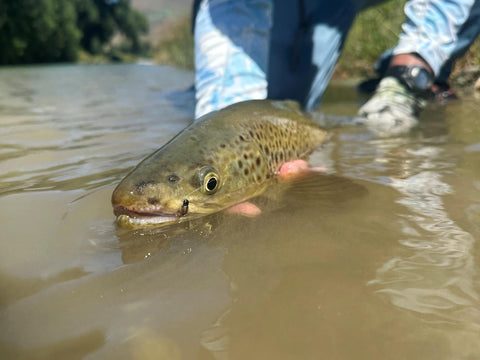Chris Dore's Depth Control flies
In fly fishing, every now and then something rocks the fly tying world. Chris Dore tends to rock the fly fishing world more often than others. The man fishes more than fish themselves so its little wonder that he's developed what will quickly become the national standard of flies - the Chris Dore Depth Control PT Nymph range
Let's hear from the man himself:
We all know that the majority of trout food found subsurface in most rivers are around a size 14 and dark. That's a fact. What changes in what you present to fish is largely dependent on the dynamics of the water you are fishing.
Is it a still backwater? Is it a gently moving pastural stream edge, a riffle or a deep, emerald backcountry gorge pool?
What about covering trout in slow, medium or then fast paced water? Are fish holding deep or feeding high in the water column? Both depth and velocity should determine how much, or how little weight you will need to get to the level at which the trout is feeding. You’re going to need a few variations on that standard 2.5mm beaded size 14 there buddy…., ya follow me?
Many anglers go to different patterns to attain differing weights. This pattern here may have a heavier bead than that one there and this one over here trumps them all in weight, common pickings at your local fly shop.
While it's true that trout will eat most flies, I get kind of fond of certain patterns and have a couple of go to's for the vast majority of my nymphing. One pattern in particular I would use in two sizes for over 90% of all subsurface work. There will usually be one of these, if not two of them in my nymphing combo at all times. If they work well and I have total confidence in them, why would I want to change them out to another fly just to get a larger or smaller bead in the mix to change the sink rate?

Dore's Depth Control PT - Unweighted
Why depth control?
On the Mataura for example, you could first work a run with a lighter set of flies, picking up those fish that are happily feeding throughout the column pre hatch, then re-fish that run with a heavier version of your killer fly to really get down to those fish that are holding tight on the streambed. Not only will the heavier nymph get deeper, all things given, but it will provide more resistance to the current and this often gets a slower, more natural drift in the softer flows down deep, whereas a lighter version will move about more naturally imitating life in the many smaller micro currents higher in the water.
In the backcountry, one fish could be sitting in that calf deep run, the next in that deep, swift drop off. You could add split shot to your standard 2.5mm bead but how will that fly fare on the next fish cruising that spooky back water where very little weight is required?
Having your favourite fly, in your favourite size, and in a variety of weights will allow you to work more water much more efficiently.
Other factors.
There are other factors in determining the sink rate of your nymphs:
- Tippet diameter and length, slack line.
- Profile and materials of your fly

What if there really was that one pattern that is a true all rounder?
Well, there is. It's Dores Depth Control PT
In this fly, we kept along the lines of a proven pattern that as anglers we all love, the ubiquitous pheasant tail nymph, but added a few buggy switch outs and of course, employed a depth control programme.

For personal preference we stuck with my favourite Kamisan B175 heavy wire nymph hook, an essential in my opinion on our larger backcountry trout in trying conditions. The heavy wire hook also gives the unweighted pattern what it needs to get below the surface, and is a hook I have 100% confidence in personally. Being a shorter hook than many others, it gives the impression of a smaller fly with the benefit of a larger hook.
We have loaded the Size 14 Dore's Depth Control PT in four weight options: Unweighted, 2mm tungsten, 2.8mm tungsten and 3.5mm tungsten beaded to cover most bases. A slotted tungsten bead is employed to primarily ensure a clear gape when employing the larger beads.

Why only size 14? Every troutstream holds dark mayfly nymphs of some breed, in size 14. Smaller sizes may become more predominant as the season goes on or in finer gravelly streams but of there are 14’s present, then trout are used to eating them. Why not give them something worthwhile, and you a break from fiddling around with tiny flies?
Do yourself a favour, dont go out and buy a dozen of the same weight - go buy 3 of each. You can better match the weight of your fly to the conditions, and mix and match weighted vs unweighted, and those inbetween for both depth, and more movement in your two nymph combo. Your catch rate this season will thank you.

View the full Manic Fly Collection
ABOUT THE AUTHOR:
Chris Dore is a battle-tested fly fishing guide with over 15 years of professional guiding experience, battling the demanding, ever-changing conditions that our New Zealand rivers throw at us.
In 2006 Chris became one of the first New Zealanders to successfully pass the internationally recognised Federation of Fly Fishers Certified Casting Instructors examination and has since taught many thousands of anglers to up their skillset.
For more in person and on river fly fishing advice and upskilling why not book Chris for a day or three?
